The Pros And Cons Of Radiant Floor Heating
Radiant floor heating is a trending solution to many standard heating problems. Most houses use furnaces, fireplaces, or gas heaters to heat their home. But with those heating systems come an array of issues.
This type of heating is quickly becoming the hottest way to heat any house. It heats your home from the floor up. Find out if it’s right for you today with this guide, including the pros and cons of such a heating system.
History Of Radiant Floor Heating

Radiant floor heating has been around for thousands of years. In Ancient Rome, slaves would stoke fires underneath elevated flooring to warm their masters. We’ve come a long way since then, but the gist is the same.
The Romans had underfloor heating called a “hypocaust.” Their floor was raised with pillars with spaces left between them. Then, a “praefurnium,” or wood-fired furnace, was put below the floor. They would even leave space for the heat to travel in slots in the walls.
Yes, the Romans were geniuses. But their way was forgotten and radiant flooring ceased to exist until the early 1900s when the first type of radiant heating was invented via radiant panels. From there, radiant heating slowly evolved into what we have today.
How Radiant Floor Heating Works

Today, we use infrared radiation to heat with radiant flooring. Radiant heating is what you feel when the sun shines down on you when you’re standing by the window or the heat you feel from a stovetop when hovering above.
It’s a comforting feeling. But it’s also quite practical. The heat is conducted through the flooring instead of through the air. There are many reasons this is better than traditional heating systems, which is what we’ll get into later.
But first, let’s talk about the different types of radiant floor heating and which ones are the most popular.
Types Of Radiant Floor Heating

While most people use one type of radiant floor heating, that doesn’t mean there aren’t other options. Each one comes with its own set of pros and cons, so perhaps another type of radiant floor heating is right for you.
Electric
Electric radiant floor heating uses electric cables that are built into the floor. This heating system is ideal if your electric company charges for time of use. If they do, and you have concrete floors, you can heat the floor and turn the heating off.
Hydronic

Our next system is called hydronic radiant floor heating, and it is by far the most popular type of floor heating. Hydronic radiant floor systems pump heated water from a boiler through tubing that is laid underneath your flooring.
If you don’t have a boiler, you’ll need a safe place for one. But if you can install one, it’s definitely worth it. Water-powered heating is ideal because of its balance between cost, safety, and eco-friendly values.
Air-Heated
Air-Heated radiant flooring is rarely used. The only benefit is that it can be paired with solar-powered systems, making it the greenest option. However, it doesn’t retain heat, so this is only useful during the day.
If you live off-the-grid, air-heated flooring is one of your only options. So it does exist for a reason. Not to mention there are certain climates where electricity isn’t quite as reliable as we’d wish.
Covering Radiant Flooring

While you can use any flooring to cover radiant floor heating, certain floorings are more efficient than others. Note that if done by a trained professional, any type of flooring is safe. If you do anything right, invest in a good contractor.
Laminate

Laminate is a fairly safe choice, no matter what type of heating you have. While laminate isn’t as good as tile, it is fire resistant, and there have been few complaints from people about laminate flooring.
The best part about laminate is that it can be taken up and put back down if you decide to retro-install radiant floor heating. The flooring is affordable, so you can buy it again, but it’s even more affordable if you can use what you already have.
Carpet
Many people use carpet with radiant floor heating, but it really isn’t the best option. If you use electrical floor heating, it can be a fire hazard. On top of that, it is also a strong insulator, so heating isn’t as easy as with other floorings.
If you use hydronic or air-heated systems, then installing carpet is safe. However, that still leaves the fact that it doesn’t distribute heat as well as other floors. Talk to a contractor if you want peace of mind yet still want to use carpet.
Tile
Tile, concrete, and stone are perfect for radiant floor heating. They conduct heat, hold temperatures, and distribute heat well. They have a nearly endless tolerance to heat too, so there are no fire hazards.
If you don’t want to wonder about safety and efficiency, then stick with tile, concrete, or stone. All extremely viable and recommended options. If you need ideas, we’ve got you covered there too!
Hardwood
As you may have guessed, a hardwood floor poses a slight fire hazard, especially if the heating isn’t installed properly. But if done right, this isn’t a problem. What is a problem is floor shrinkage, which can also happen.
Again, if a good contractor takes a look at the flooring and heating, they can make sure that your hardwood doesn’t shrink. If it does, it will leave cracks, exposing the heating, so talking to your contractor is an important step.
Linoleum
Believe it or not, lino is not flammable. It was made to resist high temperatures. It sets in the middle of the spectrum, neither the worst nor the best flooring for radiant heating. However, it is the cheapest.
Linoleum is by far the cheapest flooring you can buy. It can also be taken up and put back down even easier than laminate. So, it’s definitely a great option if you’re on a strict budget.
Pros Of Radiant Floor Heating

You may notice that there are more pros than cons of radiant flooring. But that still doesn’t mean it’s right for everyone. Read through both the pros and cons and see if the balance is exactly what you need.
Constant Temperature
Radiant floor heating is known for its ability to keep a room at a constant temperature day and night. This is because it stores heat during the day and uses it during the night. Even if the power goes out, you’ll have heat for quite a while.
Note that this is when using a tile floor. When using another flooring like wood or carpet, your room may retain heat, but the flooring will not.
Safety Factor
With radiant heating under the floor, you don’t have to worry about anyone burning themselves on a stove or heater. You also rest easy because allergens won’t be stirred up, and the air quality will be improved.
This doesn’t mean that you shouldn’t use another type of heating, it just means that in general, radiant heating is safer.
Sweet Silence
Radiant floor heating is completely silent. No more whirring, banging or kicking on and off. With this type of flooring, the only sounds you’ll hear are the ones you create. If this bothers you, you might invest in a white noise machine.
White noise machines can make your bedroom more relaxing and are actually recommended when sleeping. If you want to choose the type of white noise you hear, invest in a white noise machine.
Heating Distribution
One of the main reasons that radiant floor heating is so popular is the even heat distribution. This works for two reasons. First of all, the heat is coming from every square foot of the flooring.
Second of all, heat rises. Because of this, the heat coming from the floor starts there and rises all the way up to the ceiling. If the heat comes from the ceiling, it’s more likely to stay there instead of evenly distribute.
No Maintenance
Radiant floor heating doesn’t need to be repaired or maintained. Nothing can get to it, like rodents, and there aren’t many things that can happen to it with age. You turn it on and never have to worry about it again.
Keep in mind that there isn’t anything in this world that is without fault. Accidents can happen, but you’re much less likely to affect radiant floor heating then another type of heating system.
Long-Term Investment
Because no repairs are needed, radiant floor heating is a long-term investment. You pay the initial price and probably have a lifetime warranty. Most providers offer a minimum of 25-years for a warranty.
Comforting Heat
People with radiant floor heating tend to rave about the way that the heat feels on their feet and in the air. There’s a reason it’s compared to sunshine and warm ovens. Radiant floor heating is like a heated blanket in the winter.
Out Of Sight, Out Of Mind
All of this together brings us to the conclusion that once you install it, you don’t have to think about it again. No repairs, no more investments, and no sound. Which means you have more time to focus on what matters.
Cons Of Radiant Floor Heating
With all of these amazing pros and benefits, it’s hard to imagine there being any cons at all to radiant floor heating. However, there are cons to everything in life. Here’s what to keep in mind for radiant floor heating.
Initial Expenses
Although there aren’t repairs to worry about, radiant floor heating usually comes with a hefty price tag. The average price for materials and installation is around $2000-$5000. Sometimes, contractors charge even more.
If you hire contractors you know personally, you may be able to get a discount. But don’t forfeit safety in order to save money. This is not the time to cut corners.
Hard To Find Contractors
Because it isn’t the easiest to install, many contractors aren’t familiar with radiant floor heating, so it can be hard to find someone to install it properly. Please make sure you get someone that has experience with it.
Doesn’t Work Well Under Some Flooring
Yes, radiant floor heating can be installed under any floor, but ideally, you want to use tile, concrete, or stone. Because of this, many people prefer to choose another more affordable heating method.
Radiant Cooling Isn’t Ideal
If you want an all-in-one heating and cooling system, radiant flooring probably isn’t right for you. You can get radiant cooling, but it is usually installed on the ceiling, so it’s a completely different unit.
Conclusion
All-in-all, radiant floor heating is a solid option. It distributes heat better than any other heating system and is a safe option for anyone. So, if you can find someone to install radiant floor heating correctly, at a price you can afford, then it is most definitely right for you.
The post The Pros And Cons Of Radiant Floor Heating appeared first on Home Decorating Trends – Homedit.






